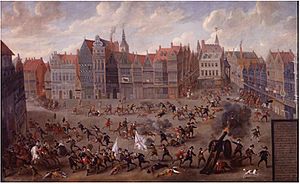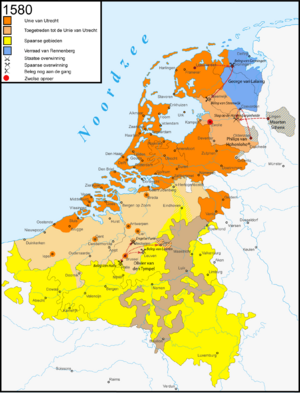English Fury at Mechelen facts for kids
Quick facts for kids English Fury at Mechelen |
|||||||
|---|---|---|---|---|---|---|---|
| Part of the Eighty Years' War | |||||||
 A painting of the capture of Mechelen by Nicolaas van Eyck |
|||||||
|
|||||||
| Belligerents | |||||||
| Commanders and leaders | |||||||
| unknown | |||||||
The English Fury at Mechelen was a major event during the Eighty Years' War and the Anglo–Spanish War. It happened on April 9, 1580. During this time, the city of Mechelen (also called Malines) was taken over. Calvinist rebel forces from Brussels captured the city. These forces included many English soldiers who were paid to fight. After the city was captured, it was badly damaged. Many valuable religious items were taken or ruined.
Contents
What Led to the Attack on Mechelen?
After a big Spanish victory in the Battle of Gembloux in 1578, the area of Brabant became a main battleground. The Dutch government (called the States-General) and Orange moved from Brussels to Antwerp. They started making Brussels and nearby towns stronger by adding soldiers.
The Dutch army was not very popular then. So, the people of Brussels asked for Olivier van den Tympel's soldiers to defend their city. These soldiers were paid by the States of Holland. Some soldiers in Mechelen were also replaced by Hollandic companies. Pontus de Noyelles became the military leader of Mechelen.
The people of Mechelen were supposed to pay the soldiers. But in November 1578, city leaders told Orange they could not afford it. There were also growing religious problems in Mechelen. The Hollandic soldiers were Calvinists, like a small group of people in the city. But most citizens were Catholic.
This led to a street fight on May 29, 1579. After this, the Hollandic soldiers left Mechelen. Governor Pontus of Noyelles then switched sides. He joined the Spanish King's forces and made peace with the Spanish leader, Parma.
By mid-1579, Mechelen was one of the few places in the Netherlands still loyal to the Spanish King. Most cities around it, like Antwerp, Brussels, and Ghent, were controlled by Calvinist rebels. In 1580, the rebels planned to take over all remaining loyal cities. This would stop the Spanish army from having strongholds behind the battle lines.
The Capture of Mechelen
Just before sunrise on April 9, 1580, rebel soldiers attacked Mechelen. They were led by Olivier van den Tympel, the Calvinist mayor of Brussels. English soldiers under John Norreys and Scottish soldiers also helped.
After a short fight with Mechelen's local guards and Spanish troops, the city was easily taken.
What Happened After the Capture?
The English and Scottish soldiers, working for van den Tympel, turned against the people of Mechelen. They took valuable items from homes, churches, and monasteries. Some gravestones were even removed from cemeteries and sold in England.
About sixty citizens were killed. Archbishop Mathias Hovius hid in a cupboard for three days. Then he escaped the city dressed as a farmer. A Carmelite monk named Petrus de Wolf fought to defend the city. He was killed by John Norreys himself.
Mechelen stayed under Calvinist control until 1585. That year, the Spanish, led by Alexander Farnese, Duke of Parma, took it back. Mechelen was one of the last cities in the Southern Netherlands to be recaptured.
This event was called the English Fury. It was named after the Spanish Fury that had happened in the city in 1572. However, the looting by the English in Mechelen lasted longer and was more intense than what the Spanish had done. Back then, war rules allowed three days of looting. But the English looting lasted for almost a whole month.
See also
 In Spanish: Toma de Malinas para niños
In Spanish: Toma de Malinas para niños


